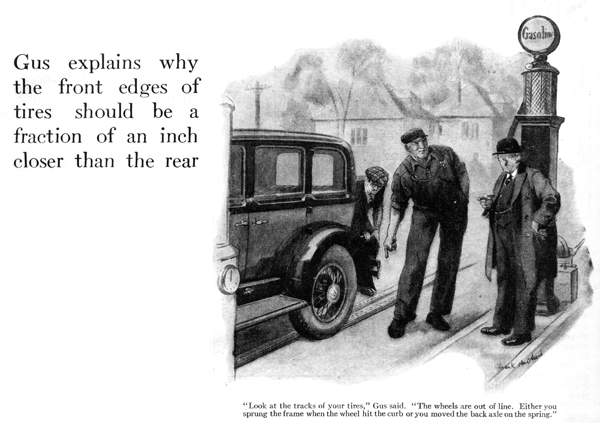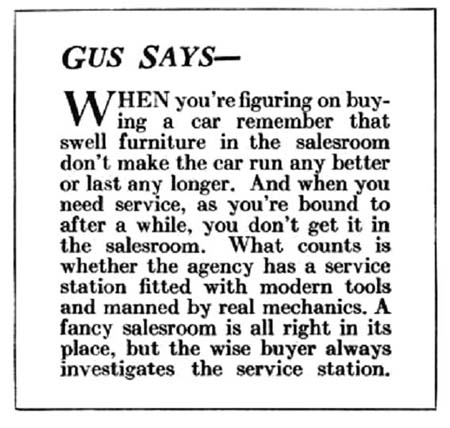April 1930
YOUR CAR IS PIGEON - TOED
by Martin Bunn

This sure is my lucky day, Gus," smiled Pop Topham as he stopped his shiny new car in front of the Model Garage.
"What did you do -- sell that corner plot for about twice what it's worth?" Gus Wilson winked at his partner, Joe Clark, as the two garage men stepped up to Topham's car.
"Oh, nothing as good as that," replied Topham. "But I just skidded into the curb and didn't hurt the car. Usually when I get something new, I manage to ruin it, first time I use it. A fellow crumbled a mudguard on my last new car before I'd gone ten miles."
"I remember that," said Gus. "Sorry to hand you bad news now, Mr. Topham, but that skid did do some damage. Look at the tracks of your tires. The wheels are out of line. Either you sprung the frame when the wheel hit the curb or you moved the back axle on the spring."
"I might have known it!" Topham groaned.
Gus leaned over to inspect the rear end of the chassis. "I guess you're lucky after all," he said at last. "It's not a sprung frame. Run your car inside and we'll line up the axle on the springs again."
Joe swung the door open and Topham drove in. Gus followed, carefully examining the tracks of the tires.
"Have you noticed anything funny about the steering?" he asked.
"It doesn't seem to steer so very easy."
"That's because the front wheels are out of line a bit, too," Gus explained. "And from the looks of the running gear, I don't think your front tires are going to last very long.
"What's the matter with them?" questioned Topham. "They look all right."
"There's nothing the matter with the tires, but the front wheels don't line up; and when that's the case, you can figure on buying one new tire after another. Just a minute and I'll show you," said Gus; and he brought out the measuring instrument designed to check the alignment of the front wheels.
''I could do this with a tape measure, he said, "but it's much easier with an outfit like this. See the front edges of the front wheels are half an inch farther apart than the rear edges. When the wheels are pointed as nearly straight ahead as you can get them they toe out. After I straighten out the rear of the car I'll adjust the tie-rod so that the wheels toe-in just about an eighth of an inch. The front edges of the tires should always be an eighth of an inch nearer together than the rear edges."
"How do you know where to make the measurements?" asked Topham interestedly. "The wheels are tipped anyhow, and I don't see how you figure where to apply the tape."
"I'll say they're tipped," said Gus. "The front wheels should have toe-in and camber and the king-pins should have a certain amount of caster."
"They seem to need lot of things all at once," said Topham, gloomily. "What do all of those words mean?"
"Well ," said Gus, "camber is the amount the wheels tip -- usually about two degrees. The outer end of each axle drops a little from the horizontal so that where the tires touch the ground they are closer together than at the top. The idea to have the point where the tires hit the road brought in under the steering knuckle. That makes steering easy. Modern cars don't have as much camber as the old-timers. They're made with better steering knuckles now and more ball bearings."
"What's the caster?" Topham asked. "The caster is the tipping of the kingpins so that the top leans back. It's kind hard to explain, but if you haven't any caster, steering is mighty hard. The center line of the steering axis in an automobile is the king-pin. If you carried it to the ground in theory, it ought to be ahead of the point where the tire makes contact with the road. You know how you can ride a bicycle with your hands off the handlebars? That's due to the caster action. So is the tendency of an automobile's wheels to straighten out after being turned. I once drove a car fifty miles that had an axle assembled all wrong. There wasn't any caster or tipping of the king-pin. By the end of the trip both arms were lame just from trying to keep the steering wheel straight."
"Good grief!" gasped Topham. "I never realized there was so much to the steering gear of an automobile."
"There's more yet," Gus smiled. "Even if the caster and camber and toe-in are right, you have trouble if the wheels wobble. What's still more important, the wheels may be out of balance. And when they are, you can't always see it. They seem to run just like any other wheels."
"How do you make a test then?" Topham asked.
"You can test for both troubles at the same time," the garage man said. "Jack up one front wheel. Give it a spin and see if it runs true. Then let the wheel slow down. If it always stops at some definite point, you can be sure it's out of balance. The tires turned out these days are marked so that they should be put on in a certain way. They are purposely made out of balance, just enough to compensate for the weight of the valve stem. If you get 'em on right the wheel will balance. If you get 'em on wrong way round, the unbalance of the tire adds to the weight of the valve stem and then you're in for grief. Even if the car doesn't shimmy every time you hit a bump, it will have a tendency to wobble."
"But suppose that the wheel is out of balance even with the tire correctly installed?" objected Topham.
"That happens sometimes," Gus conceded. "The rim may be slightly out of balance or perhaps one spoke is just a little too heavy. In a case like that, take a little sheet lead and fasten it to the rim at the point that stops at the top. You should add just enough lead so that the wheel will stop at any point and will have no tendency to roll back and forth."
"And how can you fix the camber if that isn't right?" Topham asked.
"Usually the camber is all right unless the axle is bent. If the caster is wrong that's easily fixed by dropping the axle away from the spring and putting an iron wedge between the spring and the axle, with the thin edge of the wedge pointed forward."
"Well," said Topham, "if you have the wheels lined up and the job on the rear fixed, I think I'll run along. My neighbor has been kicking about his car shimmying. I'm going to hand him some of the dope about caster and camber and maybe he can fix it."
"He can if he knows what he is about," said Gus. "Better tell him, though, that the first thing to do is to find out if the wheels wobble and whether they're in balance or not. And, if he isn't a pretty good mechanic, you'd better tell him to bring the car down here."
END
L. Osbone 2019
